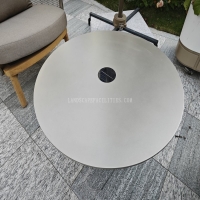Welcome to the website for landscape facilities products and knowledge.
How does the table’s design accommodate the use of wheelchairs or other assistive devices?
Modern table design has evolved significantly to create inclusive environments that accommodate wheelchair users and individuals utilizing various assistive devices. The fundamental principle driving this evolution is universal design - creating products accessible to people with diverse abilities without specialized adaptations.
The most critical design consideration is appropriate height adjustment. Unlike standard tables fixed at 28-30 inches, accessible tables typically feature heights ranging from 28 to 34 inches to accommodate different wheelchair configurations and user preferences. Many contemporary models incorporate electric or mechanical height adjustment mechanisms allowing seamless transitions between sitting and standing positions, benefiting all users regardless of mobility status.
Knee clearance represents another essential design element. The Americans with Disabilities Act (ADA) guidelines specify that accessible tables must provide at least 27 inches of vertical clearance from the floor to the underside of the table, extending 19 inches deep and 30 inches wide. This clearance enables wheelchair users to approach the table comfortably without obstruction, facilitating proper posture and reducing strain during extended use.
Table depth and leg placement significantly impact accessibility. Tables with open bases or those featuring legs set toward the rear create unobstructed space for wheelchair approach. This design allows users to position their chairs completely beneath the work surface, bringing them closer to their tasks without awkward reaching or straining.
Surface characteristics also contribute to accessibility. Matte or non-reflective finishes reduce glare that might challenge users with visual impairments. Rounded corners prevent potential injuries for all users, while durable, easy-to-clean surfaces accommodate those who might spill liquids or require frequent sanitation.
Edge design considerations include incorporating slight lips or barriers at table perimeters to prevent items from sliding off, particularly useful for individuals with limited dexterity. Some specialized tables feature cut-out sections that allow closer approach, while others include integrated power sources and cable management systems positioned for easy access without requiring excessive reaching.
Material selection plays a crucial role in both functionality and aesthetics. Lightweight yet stable materials facilitate rearrangement when necessary, while moisture-resistant surfaces withstand cleaning chemicals commonly used in healthcare and institutional settings. Advanced tables even incorporate sensory-friendly materials that dampen sound and vibration for users with sensory processing sensitivities.
Beyond physical specifications, thoughtful table design considers the complete user experience. This includes ensuring that controls for adjustable features remain within easy reach and are operable with minimal force. The growing emphasis on inclusive design means that many accessibility features now benefit all users, demonstrating that thoughtful accommodation enhances functionality for everyone in educational, workplace, and public environments.
The integration of technology represents the latest frontier in accessible table design. Some modern tables feature built-in assistive technology interfaces, wireless charging pads, and touch-free adjustment mechanisms operated through smartphone applications or voice commands. These innovations further reduce barriers for individuals with limited mobility while adding convenience for all users.
Through these multifaceted design approaches, contemporary tables transcend mere furniture function to become tools of inclusion, enabling full participation regardless of physical ability while maintaining aesthetic appeal and practical utility in diverse settings.
Related search:

Recommendation
Outdoor stainless steel table with solar-powered ambient lighting feature - excellent design.